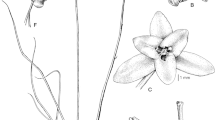Summary
A new species, Blyxa mangalensis from the low altitude coastal lateritic plateau of the west coast of South India is described and illustrated. It differs from B. senegalensis in its 12 stamens, globose anthers with connective appendages, absence of petals in the female flower, distinctly longer style and 9 – 10 longitudinal-ridged seeds.





Similar content being viewed by others
References
Cook, C. D. K. & Luond, R. (1983). A revision of the genus Blyxa (Hydrocharitaceae). Aquatic Bot. 15: 1 – 52.
____ (1996). Aquatic and Wetland Plants of India. Oxford University Press, Oxford.
IUCN Standards and Petitions Subcommittee (2014). Guidelines for Using the IUCN Red List Categories and Criteria. Version 11. Prepared by the Standards and Petitions Subcommittee in February 2014. IUCN, Gland & Cambridge.
Subramanyam, K. (1962). Aquatic Angiosperms. Botanical monographs (3), Council of Scientific and Industrial Research, New Delhi.
Acknowledgements
We are thankful to Dr Jayanthi Janakiraman, Botanical Survey of India, Pune for providing the necessary herbarium facilities and literature.
Author information
Authors and Affiliations
Corresponding author
Rights and permissions
About this article
Cite this article
Rashmi, K., Krishnakumar, G. & Les, D.H. Blyxa mangalensis, a new species of Hydrocharitaceae from India. Kew Bull 72, 2 (2017). https://doi.org/10.1007/s12225-016-9663-4
Accepted:
Published:
DOI: https://doi.org/10.1007/s12225-016-9663-4




